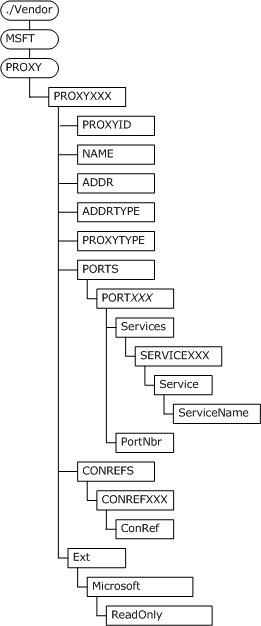 Important: Important: |
|---|
| This is retired content. This content is outdated and is no longer being maintained. It is provided as a courtesy for individuals who are still using these technologies. This content may contain URLs that were valid when originally published, but now link to sites or pages that no longer exist. |
The PROXYConfiguration Service Provider is used to configure proxy networks. Each proxy node configures a proxy connection. This proxy connection can apply to one or more connectivity objects (ConRefs), as long as the ConRefs point to the same metanetwork. One or more proxy connections can be provisioned.
The ACCESS Configuration Service Providermust be configured before configuring the PROXY object. The ACCESS Configuration Service Provider maps a particular connection (using the ConReffield) with a metanetwork, such as the Internet or Work.
 Note: Note: |
|---|
| This Configuration Service Provider is part of the OMA DM protocol, with some proprietary extensions, and must be used when provisioning devices using OMA DM. To provision devices using the OMA Client Provisioning (formerly WAP Client Provisioning) protocol, use the CM_ProxyEntries Configuration Service Providerinstead. |
 Note: Note: |
|---|
| Access to this Configuration Service Provider is determined by Security roles. Because OEMs and Mobile Operators can selectively disallow access, ask them about the availability of this Configuration Service Provider. For more information about roles, see Security Rolesand Default Roles for Configuration Service Providers. |
The following image shows the management object used by OMA DM.

- PROXY
-
The root node for PROXY object. The following table shows the default settings.
Data Type
Node
Roles allowed to query and update setting
Manager
AuthenticatedUser
Access Type
Read/Write
Occurs
Once
- PROXY/PROXY XXX
-
Specifies a proxy connection. The suggested name of this node is PROXY XXX, a numbered node beginning at zero. For example, if you wanted to provision two different proxies, each using a separate proxy server, you would use two nodes, PROXY0 and PROXY1. You can use any unique name for this node, but no spaces may appear in the node name (use %20instead).
Data Type
Node
Roles allowed to query and update setting
Manager
AuthenticatedUser
- PROXY/PROXY XXX /PROXYID
-
Specifies the identifier of the proxy. The value of the PROXYID must match a ConRefspecified using the ACCESS Configuration Service Provider. The PROXYID must be unique.
The following table shows the default settings.
Data Type
String
Roles allowed to query and update setting
Manager
AuthenticatedUser
- PROXY/PROXY XXX /NAME
-
Specifies the user-friendly name of the proxy connection.
The following table shows the default settings.
Data Type
String
Roles allowed to query and update setting
Manager
AuthenticatedUser
- PROXY/PROXY XXX /ADDR
-
Specifies the address of the proxy server. The ADDR may be the network name of the server, or any other string (such as an IP address) used to uniquely identify the proxy connection.
The following table shows the default settings.
Data Type
String
Roles allowed to query and update setting
Manager
AuthenticatedUser
- PROXY/PROXY XXX /ADDRTYPE
-
Specifies the type of address used to identify proxy server. This value is always set to "IPv4" for proxy servers.
The following table shows the default settings.
Data Type
String
Roles allowed to query and update setting
Manager
AuthenticatedUser
- PROXY/PROXY XXX /Ext
-
Stores extended parameters.
- PROXY/PROXY XXX /Ext/Microsoft
-
Stores Microsoft-specific parameters.
- PROXY/PROXY XXX /Ext/Microsoft/ReadOnly
-
This parameter determines whether users are able to modify proxy settings. Permitted values are 0 for false and 1 for true. If the value is set to 1, users will be able to view, but not change, the proxy settings on the device.
The following table shows the default settings.
Permissions
Read/Write
Data type
Boolean
Roles allowed to query and update setting
Manager
Operator TPS
- PROXY/PROXY XXX /PROXYTYPE
-
Specifies the type of proxy. This value is set to one of the following values, depending on the PROXYID: ISA, WAP, SOCKS, or NULL.
The following table shows the default settings.
Data Type
String
Roles allowed to query and update setting
Manager
AuthenticatedUser
- PROXY/PROXY XXX /PORTS/PORT XXX /Services/SERVICEXXX/Service/ServiceName
-
Specifies the protocols to be associated with the port specified by PORT XXX. One commonly used value is "HTTP".
The following table shows the default settings.
Data Type
String
Roles allowed to query and update setting
Manager
AuthenticatedUser
- PROXY/PROXY XXX /PORTS/PORT XXX /PortNbr
-
Specifies the port number to be associated with the parent port.
The following table shows the default settings.
Data Type
Int
Roles allowed to query and update setting
Manager
AuthenticatedUser
- PROXY/PROXY XXX /CONREFS/CONREF XXX /ConRef
-
Specifies one single connectivity object associated with the proxy connection. The value must match a ConRefspecified using the ACCESS Configuration Service Provider.
The following table shows the default settings.
Data Type
String
Roles allowed to query and update setting
Manager
AuthenticatedUser








 See Also
See Also